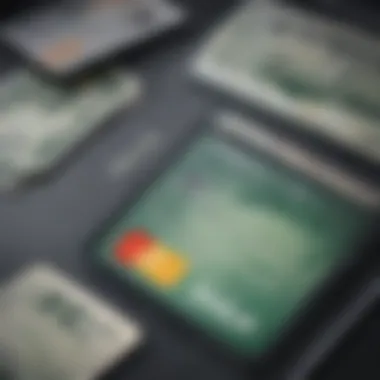Understanding Cash Cards: Functions, Benefits, and Risks


Intro
With the rise of digital payments, the concept of cash cards has become more prominent and relevant. Cash cards, often seen as a bridge between traditional banking and the fast-paced world of online transactions, are not only convenient but also packed with features that can enhance financial management. In this guide, we will unpack what cash cards are, how they function, their benefits and some potential pitfalls, providing a holistic view essential for informed financial decisions.
The digital economy demands flexibility and security, and cash cards offer both. They can be used for various transactions ranging from daily purchases to online services, making them an excellent tool for both budgeting and convenience. As we navigate this guide, you'll find key definitions, types of cash cards, and the necessity of understanding their security features.
Investment Dictionaries
When diving into the realm of cash cards, it's essential to familiarize oneself with key terms that help clarify their workings and relevance. Below are some crucial financial terms related to cash cards.
Key Financial Terms
- Cash Card: A plastic card used for making electronic cash transactions, usually connected to a bank account or payment service.
- Prepaid Card: A card that is pre-loaded with a specified amount of money, allowing the user to spend it until the balance reaches zero.
- Reloadable Card: A type of prepaid card that can be reloaded with additional funds after the initial balance is used up.
- Virtual Card: A non-physical digital card that can be used for online purchases. It often provides enhanced security features.
- PIN (Personal Identification Number): A secure code used to authenticate transactions made with cash cards.
Investment Jargon Explained
Understanding the lingo can often simplify the decision-making process when selecting the right cash card. Here are a few phrases that often come up:
- Transaction Fee: A charge incurred for processing a transaction, which can vary by provider.
- Balance: The remaining amount available to use on a cash card.
- Account Linking: Refers to the association of a cash card with a bank account or a payment app for easier fund transfers.
- Fraud Protection: Security measures that companies deploy to safeguard against unauthorized transactions.
Financial Product Reviews
Analyzing cash cards helps consumers make informed choices. The variety available means that weighing the pros and cons is crucial for financial success.
Comparative Analysis of Products
Not all cash cards are created equal. For instance:
- Green Dot Prepaid Visa Card: Offers online bill pay and has a low monthly fee but charges for ATM withdrawals.
- PayPal Prepaid Mastercard: Great for those who already use PayPal, but it has transaction fees that could add up.
- NetSpend Visa Prepaid Card: Offers flexible budgeting features and free direct deposit, however, there can be activation fees.
Pros and Cons Evaluation
Like any financial product, cash cards come with their strengths and weaknesses:
Pros:
- Flexibility in spending; great for budgeting.
- Enhanced security compared to cash.
- No overdraft fees, making it safer for financial planning.
Cons:
- Potential for high fees if not used wisely.
- Limited features compared to credit or debit cards.
- Not all cash cards build credit history.
"Understanding how cash cards work can be the difference between losing and saving money in daily transactions."
Defining Cash Cards
Understanding the essence of cash cards is crucial for navigating today's financial landscape. These cards, versatile in nature, serve not just as transactional tools but also as money management devices, catering to a variety of needs. As we delve into what cash cards are, their historical context unfolds an intricate tapestry of convenience, innovation, and adaptability that continues to shape consumer experience in commerce.
What is a Cash Card?
A cash card, in simple terms, is an electronic payment card that allows users to access funds stored in a cash account, typically without needing a traditional bank account for carrying out transactions. Users can load funds onto these cards, which they can then use for various purchases or ATM withdrawals, functioning much like a debit card. However, unlike traditional bank accounts, the money must be preloaded on the card before it can be spent, thus controlling overspending effectively. This feature makes cash cards an attractive option for those who want to maintain strict budgeting practices or who may not qualify for standard credit cards.
Cash cards can take several forms, including prepaid and debit types, each designed to meet specific consumer needs. They often come with features such as online management tools and mobile app access, enhancing user experience and control. Overall, cash cards embody a blend of usefulness and practicality in everyday transactions.
History and Evolution
The journey of cash cards traces back several decades, evolving with the ever-changing economic landscape. The emergence of electronic banking in the late 20th century spurred the development of these financial tools. Originally, cash cards resembled standard debit cards but metamorphosed over time into specialized variants that catered specifically to the unbanked population, essentially bridging the gap between cash and digital payments.
In the 1990s, advancements in technology and customer needs propelled the introduction of prepaid cash cards, which allowed individuals to load a set amount of money onto a card for specific purchases without incurring debt or fees associated with overdrawing an account. As technology further progressed, online platforms emerged, allowing users to load and manage their cash cards seamlessly, ultimately leading to the rise of virtual cash cards linked to online accounts.
Today's landscape of cash cards is profoundly shaped by consumer behavior and technological innovations. With the integration of mobile wallets and contactless payment systems, cash cards have adapted to meet the demands of an increasingly digital world. Their evolution reflects a shift toward flexibility and accessibility, empowering consumers to manage their finances with greater ease.


Types of Cash Cards
In the landscape of modern financial instruments, cash cards have carved out a significant niche. Understanding the types of cash cards one can encounter is crucial for making informed financial choices. Each type presents its own set of features, advantages, and considerations. When equipped with this knowledge, users can navigate their financial transactions with greater ease and insight.
Prepaid Cash Cards
Prepaid cash cards essentially function like a portable wallet. They are loaded with a specific amount of money before they can be used, making them particularly useful for people who want to manage their spending. One of the standout advantages of prepaid cards is that they can help curb overspending. By limiting the available funds to what has already been loaded, users avoid falling into the trap of debt that can sometimes ensnare those using traditional credit lines.
Moreover, prepaid cash cards are often highly accessible. No credit check is needed, which makes them a lifeline for those without bank accounts or for younger individuals who may not yet have established credit histories. They serve various purposes, from gifting to personal budgeting and even travel. Just remember to review the terms carefully, as some cards come with fees for loading and reloading money or using ATMs.
Debit Cash Cards
A debit cash card is often linked directly to a bank account—think of it like a key that opens the door to your cash. With a debit card, spending is automatically deducted from the linked account, providing immediate access to your funds. This immediate deduction can be beneficial for those who wish to keep a close eye on their finances and avoid overspending, as it removes the temptation of borrowing money that comes with credit cards.
Debit cash cards typically come with a broader acceptance rate than their prepaid counterparts and can be used at a wider range of retail outlets, restaurants, and online platforms. Furthermore, unlike prepaid cards, there may be minimal or no fees for transactions, depending on the banking institution. That said, users should remain aware of potential overdraft fees if they happen to withdraw more than what’s available in their account.
Virtual Cash Cards
As technology continues to evolve, virtual cash cards have emerged as a notable option. These cards exist solely in a digital format and are often used for online transactions. They carry the same functionalities as traditional cards but come with the additional benefit of enhanced security. Virtual cash cards can generate unique numbers for every transaction, so the risk of fraud is significantly mitigated.
User convenience is another strong suit. Since they do not need physical storage, they are perfect for individuals who regularly shop online or engage in digital services. Being able to access funds and execute transactions from anywhere, at any time, makes virtual cash cards a compelling choice in our increasingly digital world. However, they might not be suitable for situations where cash is king, such as certain local markets or informal sales, which can limit their usability in specific contexts.
"The emergence of virtual cash cards signifies the blending of finance with digital innovation, reshaping how we think about carrying money."
Functional Aspects of Cash Cards
Understanding the functional aspects of cash cards is critical for anyone looking to navigate today's financial landscape. Cash cards offer an alternative to traditional banking methods, specifically in how users interact with their finances. Knowing how to load money, make transactions, and deal with reloading or expiration issues can make or break a cash card experience. Let's delve into these elements.
Loading Money onto Cash Cards
Loading money onto a cash card is often the first step users encounter. This process typically involves transferring funds from a bank account, depositing cash, or using direct deposits from an employer. Common platforms for loading include retail locations, mobile banking apps, or ATMs associated with the cash card provider. Each method presents unique advantages:
- Retail Locations: Many retailers allow users to add funds directly to their cash cards at the register, making it a convenient option.
- Mobile Banking Apps: This method allows users to manage their finances remotely, transferring money easily with just a few taps.
- Direct Deposits: For those who prefer a hands-off approach, setting up direct deposits can automatically load the card with funds upon receipt of paychecks.
Moreover, understanding potential fees associated with loading is vital. Some providers charge fees for loading cash; others might not. A close examination of these costs is wise to avoid any unexpected surprises.
Making Transactions
Once loaded, how does one actually use a cash card for purchases? Transaction processes can feel second nature, yet they differ a bit from traditional credit or debit cards. Users can make purchases both online and in physical stores. At checkout, simply swiping the card or entering card details online completes the transaction.
It's essential to consider the following:
- Transaction Limits: Each card may have different daily or monthly limits on spending. Being aware of these restrictions can prevent inconvenience at the register.
- Merchant Acceptance: Not all merchants accept cash cards, which can be a drawback compared to standard debit or credit cards.
- Security Features: Modern cash cards often come equipped with security measures such as transaction alerts and the ability to freeze the card through an app. This adds an extra layer of security to your finances.
"Cash cards provide a convenient method for managing spending while offering distinct advantages and limitations compared to traditional banking products."
Reloading and Expiry Issues
What happens when the funds dwindle? Reloading cash cards is relatively straightforward, provided users understand the process. Many of the methods mentioned earlier for loading can also be used to reload. Users should be aware, however, of expiration dates associated with cash cards. Depending on the card type, funds may not remain indefinitely. Unused balances can lead to fees or loss, so keeping an eye on expiration is prudent.
Additionally, users should consider:
- Automatic Reload Options: Some cards allow users to set automatic reloads, ensuring that funds are regularly topped up without any effort on their part.
- Transfer Methods: Knowing which methods are available for reloading—like bank transfers or cash deposits—helps in planning future transactions.
- What to Do with Expired Cards: Each cash card provider has its own policy for expired cards—understanding this can save frustration in the future.
Navigating these functional aspects of cash cards informs users on how to effectively manage and utilize these financial tools. Whether for budgeting or simply a more convenient payment method, the knowledge gained from this section enhances financial literacy in a rapidly evolving economic environment.
Advantages of Using Cash Cards
When it comes to managing finances in the modern world, cash cards have carved out a notable space. It's not just about how you spend; it’s also about how you control and monitor your money. Recognizing the advantages of these financial tools can equip individuals with a better understanding of their fiscal responsibilities.
Budgeting and Financial Management
One of the standout features of cash cards is their inherent ability to support budgeting and responsible financial management. When utilizing a cash card, you essentially pre-load a specific amount, which can instill a disciplined approach to spending. This helps in creating clear boundaries, preventing overspending that often sneaks up on traditional credit card holders.
Imagine you load $200 onto your card for the month. As the days pass, you can easily monitor your balance, see what you've spent, and adjust spending habits accordingly. It's like a personal finance class practically in your pocket.


"Managing finances with a cash card can feel like having a financial coach guiding your everyday expenses."
Moreover, many cash cards come equipped with budgeting tools within their apps that provide insights into spending categories. You can see where money drips away, which is invaluable for making informed decisions. Tracking trends can also help you identify areas where you can cut back, ultimately nurturing a more sustainable financial lifestyle.
Security Features
Security is always a priority when it comes to handling money. Cash cards, particularly prepaid and some debit cards, offer security features that give users peace of mind. Many of these cards include embedded chip technology, which makes it much harder for fraudsters to replicate card information compared to traditional magnetic stripe cards. They also allow for easy blocking in the event your card gets lost or stolen, significantly reducing the potential for unauthorized transactions.
Furthermore, many cash cards provide individualized security measures such as transaction alerts. If you set up notifications, you’ll get real-time updates straight to your phone about account activity. If something appears fishy, you can act promptly, which is better than waiting for a monthly statement.
Ease of Use
The user-friendly nature of cash cards is another important aspect worth mentioning. Getting started with a cash card is typically straightforward—essentially you just need to acquire a card, load it up, and you're ready to go. This simplicity often appeals to those who might feel overwhelmed with traditional banking processes.
You can use cash cards like you would a debit card, making purchases online or in-store without the hassle of linking multiple bank accounts. This ease extends to their reloadability; many cards can be topped off at ATMs or through affiliated stores, which is much easier than dealing with checks or cash deposits.
For any investor or financial advisor, knowing that their clients or themselves can quickly manage funds without jumping through hoops can change the game. Spend, reload, manage—that's the rhythm cash cards contribute to modern finance.
In summary, it’s clear that cash cards are more than just a tool for transactions; they are integral to budgeting, security, and user experience. Each time you reach for your card, you are part of a broader financial ecosystem that encourages responsible spending and enhances security.
Potential Drawbacks and Challenges
While cash cards offer numerous benefits, it's also crucial to consider their potential drawbacks and challenges. This discussion serves a dual purpose: it aids users in navigating the nuances of cash card usage and highlights the limitations they might face. Addressing these issues can make a significant difference in the overall management of one's finances.
Fees Associated with Cash Cards
Many users find themselves caught off guard by the various fees tied to cash cards. It’s not just a simple matter of loading money and spending it; there can be a slew of associated charges that can chip away at your balance. Common fees include:
- Activation fees when first obtaining a cash card.
- Reload fees, which can accumulate each time you add funds.
- Monthly maintenance fees, particularly for cards that offer premium services or additional features.
- ATM withdrawal fees, especially if the card is used outside its network.
Understanding these fees is essential for anyone considering a cash card. They can sometimes negate the advantages of using these instruments, causing frustration and limiting overall usability. Checking the fee structure carefully can save you from being caught in a web of unexpected charges.
Limited Acceptance and Usability
Cash cards, while versatile, are not universally accepted. This can lead to inconvenient situations where you might be left scrambling to make a purchase. Some points to consider include:
- Merchant Restrictions: Not all merchants accept cash cards. This is especially true in certain regions or with smaller vendors.
- International Use: Using cash cards abroad can be another minefield. Some cards aren’t compatible with foreign currencies, which can lead to additional fees or the inability to carry out transactions altogether.
When relying on a cash card, especially for travel or online shopping, it’s wise to double-check if the specific vendors or platforms you intend to use will accept it. Ultimately, understanding these limitations promotes better planning and can keep you from awkward or financially troublesome situations.
Fraud Risks and Protections
In this digital age, fraud risks are a persistent concern. While cash cards often come equipped with security features, they are not entirely foolproof. Some points to ponder include:
- Vulnerability: Cash cards can be just as susceptible to fraud as credit or debit cards, particularly if personal information is exposed.
- Limited Protection: Unlike some credit cards, which offer comprehensive fraud protection, many cash cards lack robust recourse. If unauthorized transactions occur, recovering lost funds may prove more difficult.
To mitigate these risks, users should employ prudent measures such as regularly monitoring account activity, using strong passwords, and activating transaction alerts wherever possible. It's essential to understand both the protections offered and the risks involved in using cash cards to ensure that the financial tool works for you, not against you.
"Financial tools should empower users rather than serve as a source of anxiety."
By delving into these potential drawbacks and challenges, users can approach cash cards with a more informed mindset. This empowerment can lead to better financial decision-making, aligning with personal goals and needs.
Comparative Analysis of Cash Cards vs. Traditional Banking
In today's fast-paced financial landscape, it's vital to take a closer look at the myriad of options available to consumers. Cash cards, especially with the growing wave of digital transactions, can sometimes seem like a sturdy alternative to traditional banking methods. In this section, we delineate the contrasts between cash cards and conventional banking, which helps in making informed decisions about personal finances.
Accessibility and Convenience
When we talk about accessibility, cash cards certainly offer a feather in their cap. They can be acquired without a bank account, making them an excellent choice for those who might be outside the traditional banking system.
- Activation and Usage: Most cash cards can be activated online or at retail locations with minimal hassle. Once activated, using them is akin to wielding a debit card—just swipe and go.
- Geographic Reach: Cash cards can often be used in a wide array of locations, from local grocery stores to international online merchants. With some cards supporting multiple currencies, travelers might find this particularly beneficial.
- 24/7 Access: Unlike banks, which might have limited hours or infrastructure issues, cash cards provide users constant access to their funds, leading to a more seamless financial experience.


However, one must consider that traditional banks provide services such as checks, loans, and investment accounts, which cash cards lack. Consequently, while cash cards excel in accessibility, traditional banks maintain a more comprehensive financial service portfolio.
Cost Efficiency
Diving into the domain of cost, cash cards can surface as economical tools for daily transactions. Nevertheless, it’s essential to look closely at the fine print.
Pros:
- Lower Fees: Cash cards typically have lower fees than traditional banking, especially in monthly maintenance charges. This can benefit those looking to manage small expenses without the burden of high overhead costs.
- Spending Control: By preloading a cash card, users can cap their spending, avoiding overdraft fees associated with debit and credit cards of banks.
Cons:
- Unknown Charges: While cash cards can have nominal fees, they may sometimes include hidden charges for reloading or withdrawing cash. Awareness of these can help users avoid unwarranted expenses.
- No Interest Accumulation: Funds stored on cash cards do not earn interest, unlike traditional savings accounts. This loss of potential growth can be a drawback for savers looking to maximize their returns.
User Experience and Satisfaction
User experience can often dictate how successful a financial product becomes. Cash cards have made strides here, but they still present unique challenges.
- Simplicity: Many consumers find cash cards straightforward to use. They may appreciate the lack of complexity compared to navigating traditional banking apps, making instant transactions a breeze.
- Customer Support: However, the fact remains that support for cash card users can sometimes be lacking. Traditional banks often offer extensive customer service, including one-on-one meetings—something that cash card providers may not prioritize.
"In the end, every financial tool has its place, but knowing when and how to use them is crucial for maintaining healthy personal finance."
For further detailed information, you may refer to sources such as Britannica, Wikipedia, or discussions on Reddit about cash cards and banking comparisons.
Future Trends in Cash Cards
In recent years, cash cards have begun to carve out a significant niche in the financial ecosystem. As we peer into the future, several trends emerge that could redefine the way users interact with these financial instruments. The integration of technology, changes in consumer behavior, and shifting economic landscapes are poised to enhance both the functionality and popularity of cash cards. Understanding these elements is crucial not just for users but also for investors and financial advisors who aim to make informed decisions in this evolving market.
Technology Integration
Technology plays a pivotal role in the progression of cash cards. With innovations such as contactless payment systems, mobile wallets, and blockchain technology, the landscape is changing rapidly. Integration of Near Field Communication (NFC) enables users to complete transactions with a simple tap. This seamless interaction not only speeds up the payment process but also enhances user satisfaction.
Moreover, advancements in mobile app functionalities mean cardholders can manage their funds more effectively. For instance, many cash cards now come with dedicated apps that allow real-time tracking of spending, budgeting tools, and instant alerts on transactions. Such features encourage users to adopt responsible money management habits.
Another significant trend is the incorporation of enhanced security measures. With the rise in cybercrime, cash cards are increasingly integrating biometric authentication, such as fingerprint and facial recognition. These technologies provide an extra layer of security that builds consumer trust.
"Consumer safety is no longer an option; it’s a necessity!"
Evolving Consumer Preferences
As the digital age progresses, consumers' preferences are shifting. Today's users prioritize convenience, flexibility, and control over their finances. They are gravitating towards solutions that empower them without compromising security. Cash cards are meeting these demands by offering features that cater to the on-the-go lifestyle of modern consumers.
For young adults and tech-savvy individuals, the appeal of cash cards lies in their ease of use and instant access to funds. With online shopping booming, many prefer prepaid or virtual cash cards that allow for secure online transactions. This demographic values the ability to control their budgets with preloaded amounts, reducing the risk of overspending.
Moreover, as consumers become more aware of the environmental impacts of financial services, there’s a noticeable shift towards sustainable practices. Fintech companies are responding by creating cash cards made from recycled materials or digital options that eliminate the need for plastic altogether. This trend not only appeals to eco-conscious users but also signals to investors that there’s potential growth in sustainable financial products.
Closure
Navigating the complexities of cash cards is akin to holding the keys to a modern financial toolkit. Understanding their myriad benefits as well as potential challenges is essential, especially in today’s fast-paced digital economy. For investors, financial advisors, students, analysts, and coaches alike, recognizing how cash cards interact with overall financial strategies can prove invaluable.
Summary of Cash Card Benefits and Challenges
While cash cards offer a host of advantages, it's crucial to weigh these against their limitations. Here’s a structured look at both sides:
- Benefits:
- Challenges:
- Flexibility and Control: Cash cards allow consumers to load specific amounts, promoting smarter budgeting.
- Security Features: Many cash cards come equipped with features like two-factor authentication, minimizing fraud risk.
- Ease of Transactions: The convenience of making purchases without the need for cash makes them a useful tool for many.
- Associated Fees: Some cash cards might come with hidden charges, such as monthly maintenance or transaction fees.
- Acceptance Issues: Not all vendors accept cash cards, which can lead to inconveniences during transactions.
- Fraud Risks: While there are protections, cash cards are still susceptible to fraud, and users must remain vigilant.
Understanding these aspects equips users with the knowledge necessary for informed decisions regarding cash card usage.
Final Thoughts on Cash Card Usage
In the end, whether one is relying on a prepaid card for budgeting, a debit card linked to a checking account, or a virtual card for online shopping, each offers unique considerations that demand careful thought. By equipping oneself with the relevant knowledge regarding cash cards, consumers can navigate this financial landscape confidently and securely.
"In today's digital economy, understanding cash cards is not just an option; it’s a necessity for prudent financial management."
By synthesizing the insights detailed throughout this guide, one can foster a more empowered approach to financial health.



